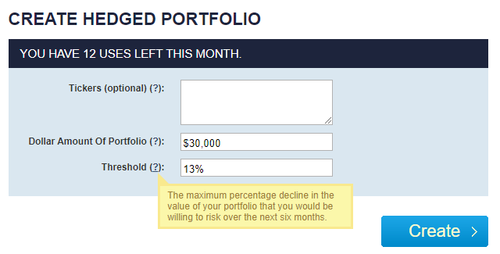Hedging Doesn't Have To Mean Lagging The Market
The conventional view is that if you hedge, you're going to lag the market, except for periods where the market is down. This is true if you are also investing in the market: the cost of hedging will be a drag on your returns in an up market.
But there's another approach that gives you a chance of beating the market while hedging.
Another Approach
The basic idea here is to buy and hedge a handful of promising names that are relatively inexpensive to hedge. Here's the process we use do that:
- Estimate potential returns over the next six months for every security with options traded in the U.S.
- Calculate the least expensive way of hedging each of those securities while capturing that estimated return.
- Subtract the hedging cost from the estimated returns, and rank the names by estimated return net of hedging cost.
- Buy and hedge and handful of the top names.
There's a bit more to the process than that--we also include a step to minimize cash, since everything's hedged--but that's the basic idea.
Sounds Like A Pain To Do
Manually, it would be, sure. But we have it set up where you just type in the amount of money you want to invest, the largest drawdown you're willing to risk, and our robot does the rest.
The interface looks like this.

This and subsequent screen captures via the Portfolio Armor web app.
A Real World Example
And this is the portfolio our site created for an investor entering that info at the end of March, someone with $30,000 to put to work who wasn't willing to risk a decline of more than 13% over the next six months:

Abercrombie & Fitch, Inc. ANF and Super Micro Computer, Inc. SMCI were the two stocks that came to the top of that ranking we mentioned above: estimated returns net of hedging cost. Our site started with rough equal dollar amounts of both, and then rounded them down to round lots, to lower hedging cost. Then it put most of the cash leftover from that rounding-down process into a tightly hedged position in Viking Therapeutics,Inc. VKTX, that generated a net credit of about 7%.
How That Hedged Portfolio Did
Over the next six months, that hedged portfolio was up 23.28%, net of hedging and trading costs, versus 5.18% for the SPDR S&P 500 Trust ETF SPY.

Not Every Hedged Portfolio Will Be A Winner
You're going to get more variability of returns with this approach than you would by indexing, as you would expect from a concentrated portfolio. But you'll never be down more than the risk tolerance you indicated ahead of time. For example, the portfolio our site created for an investor with the same inputs a week earlier ended up losing about 7% over the next six months.
One way to even out this sort of variability is to split your money into a couple of tranches and put half to work now, and the other half to work in two or three months. That way, the +23% return will offset the -7% returns.
This content is for informational purposes only and is not intended to be investing advice.
© 2024 Benzinga.com. Benzinga does not provide investment advice. All rights reserved.
Trade confidently with insights and alerts from analyst ratings, free reports and breaking news that affects the stocks you care about.